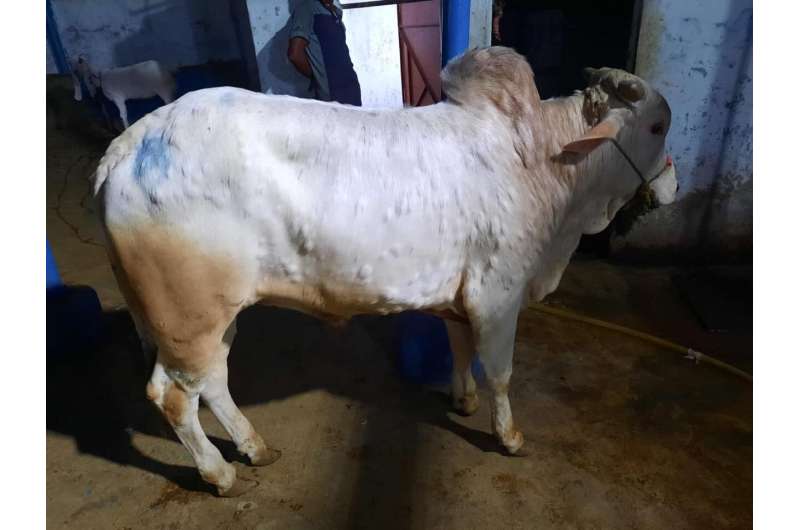Fears of lumpy skin disease resurgence at Eid festival

While Pakistan has managed to confine an outbreak of lumpy skin disease that affects cattle and buffaloes there are fears that cattle fairs ahead of the religious festival Eid-ul-Azha might trigger a second wave.
The viral disease spread by insects can seriously affect cows' milk production and damage reproductive organs, say animal health experts.
Vaccines arrived from Turkey in early April, five months after the first reported cases in Pakistan, and within two weeks of free-of-charge administration to 1.9 million cattle, the disease had begun to subside.
"Our target (for Sindh province) is four million cattle by June," said Nazeer Hussain Kalhoro, director-general of the Sindh Institute of Animal Health, Karachi. Overall, there are 42 million buffaloes and 51 million cattle in Pakistan, according to the Ministry of National Food Security and Research.
But Eid ul Azha—a religious festival where animals are sacrificed falling in the second week of July—could result in a second wave of the disease if the customary cattle fairs are allowed to go ahead, warns Zaka Ullah Pathan, a veterinarian based in Khairpur, Sindh province.
Shahbaz Rasool managed to get his herd of 40 cows vaccinated against the fast-spreading, lumpy skin disease in the nick of time last week, but the danger is far from over.
"I will know for sure after 28 days if they are out of danger," the dairy farmer told SciDev.Net by phone from Gujrat, in Punjab province.
Rasool decided not to wait for the government to vaccinate his animals and bought the imported vaccine. A 100-milliliter bottle is selling for PKR 44,000 (US$220) and 1 milliliter is needed per cow.
Livestock contributed 60.1% of the agriculture and 11.5% to the gross domestic product during the 2021 financial year, according to the Pakistan Economic Survey 2020–21. Milk is the most important commodity in the livestock sector. Pakistan is ranked fourth in milk production worldwide after China, India and the U.S.
Rasool's is among eight million families engaged in the livestock industry. He is worried that if the disease is not contained it will wipe out many small dairy farmers. The vector-borne virus that causes lumpy skin disease is found among cows and water buffaloes and is spread primarily through biting insects like mosquitoes and ticks. It first surfaced in Zambia in 1929.
Infected cattle typically suffer from "high temperature, much discomfort and loss of milk production," says Tahir Yaqub, spokesperson of the University of Veterinary and Animal Sciences, Lahore.
"The nodes developed on the body look rather unsightly and may carry pus if there is bacterial infection. However, it is fine to consume meat and milk from an infected animal provided it was cooked well and the latter pasteurized properly," he added.
If a female cow is infected, its reproductive organs are badly affected, says Pathan. In addition, the milk productivity of a cow producing eight liters on an average will drop down to less than 1.5 liters.
In Karachi, provincial capital of Sindh, Shakir Umer Gujjar, president of Pakistan's Dairy and Cattle Farmers Association, said as the disease spread people stopped buying milk causing enormous losses to farmers who then were compelled to sell the milk to big companies at vastly reduced prices. "They bought our milk for as little as PKR 800 (US$4) for 40 liters instead of the standard rate of Rs 4,780 (US$24) for 40 liters—we were thankful for even that," said Gujjar.
The disease, which has already infected animals in India and Iran, was first reported in Pakistan in November 2021 from Bahawalpur, Punjab province. "Animals often cross borders and may have come from India where the disease was already present," says Kalhoro.
On the potential of a resurgence around Eid ul Azha, Kalhoro reassured that there would be several checkpoints at the borders between Punjab and Sindh to screen animals and turn back infected ones. "They will need to be certified to be healthy and vaccinated, like the cards we carry to show for COVID-19 vaccination," he said.
Yaqub suspected the disease to have originated with imported livestock landed at the port of Karachi last year. According to Pathan, of the 28 animals that were imported "none were quarantined" as required.
Guijar supported Kalhoro's assertion that the disease subsequently spread in the port city of Karachi, where commercial farming is practiced on a large scale. "After writing to top officials and even the prime minister, the government finally took action, but the damage was done," said Gujjar.
"Had I not created a noise, the disease would have devastated the entire cattle population of Pakistan, but has now been contained in Sindh. We even sent samples to the National Veterinary Laboratory, in Islamabad," said Kalhoro. "It took them till 4 March to confirm and declare the outbreak officially."
Provided by SciDev.Net


















